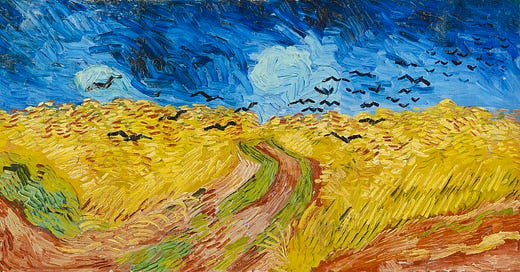Empty Your Cup
How the Buddhist Concept of Non-Attachment Can Help You Navigate Loss and Uncertainty
Housekeeping
Hello, my fellow Bread Crumbers!
As I mentioned in Money Games Part 5 and last year’s Annual Letter, Bread Crumbs will rotate between the topics of finance, philosophy, and spirituality. I’ll take a concept from one of these disciplines, extract the most useful insights, and explore how to apply them to daily life.
Since becoming someone who consistently(ish) meditates, I’ve found value in Eastern wisdom traditions—specifically, Buddhism. As a Catholic, it’s been fascinating to see how, despite their differences, both traditions ultimately address the same core problem - human suffering.
One of the teachings I’ve found most helpful—yet challenging—to practice is non-attachment. It’s not always easy, but in this case, the juice is worth the squeeze.
This essay is a brief introduction to the concept of non-attachment. I hope you enjoy it.
Life and loss are inseparable companions. You will lose the things you hold most dear. We all will.
So, what should we do?
A Buddhist might point you to the idea of dukkha. Roughly translated, dukkha refers to something that is unpleasant to experience. In Buddhist circles, dukkha is seen as the ever-present reality of life. It arises from attachment to cravings and the aversion to discomfort. Fear of loss is an example of aversion. The solution to this constant suffering is not immediately intuitive. In my life, I often find my mind’s immediate reaction to the idea of losing something or someone is to banish the thought. That rarely works. The thought comes back twice as strong. Why?
Our mammalian brains are wired for survival, not peace. For our hunter-gatherer ancestors, losing food, water, or shelter could mean life or death. Those who were hyper-aware of potential loss had a better chance of surviving than their more relaxed counterparts. Over time, they passed their neurotic (but lifesaving) genes down to us.
In modern life, these neurotic genes cause more harm than good. The Buddhist concept of non-attachment is the best tool I’ve found for dealing with them. It serves as a counterbalance to dukkha. Non-attachment is the practice of putting into action the basic truth that everything is impermanent. This is not the same thing as detachment.
Non-attachment does not mean apathy or indifference. It does not mean that you stop caring about the people, goals, or experiences in your life. Instead, it is about loosening your grip—understanding that while you can appreciate and engage with the world, you do not have to be controlled by it.
Detachment, on the other hand, is shutting down—a way of keeping life at arm’s length to avoid pain. Non-attachment is the opposite: it is an opening up, a way of fully experiencing life without being enslaved by fear, desire, or insecurity.
At its core, non-attachment is about accepting what is, rather than clinging to what was or what could be. It is the practice of allowing life to unfold without trying to force or resist its natural flow.
Think of a golfer gripping the club too tightly. The harder he squeezes, the more rigid his swing becomes. He overcompensates, overthinks, and tries to muscle the ball into place. But instead of power, he gets tension. Instead of control, he gets erratic results. In contrast, the best golfers know that a looser grip—one that allows for fluidity and rhythm—produces the best shot. By trusting the motion rather than forcing it, they generate more power with less effort.
From a Buddhist perspective, life works in a similar way. When we cling—to relationships, to status, to outcomes—we create suffering. We are wired to grasp, to crave certainty, to seek permanence in a world that offers none. But the more we try to hold on, the more we suffer. Non-attachment is the practice of loosening that grip. It is the ability to love fully without needing to possess, to work hard without being defined by success or failure, and to engage with life without being consumed by it.
This does not mean we abandon ambition or connection. Rather, we pursue them with an understanding that nothing is truly ours to keep. And in that realization, we find a kind of freedom—a liberation from the constant anxiety of loss, the endless chase for control.
Non-attachment is not passive resignation; it is active presence. It is showing up for life without the desperate need to make it something other than what it is. It is the ability to hold life gently—just as a great golfer holds his club, trusting the swing rather than forcing it.
A simple way to put this philosophy into practice is to ask yourself, “What am I craving or avoiding?” the next time you feel emotional discomfort. More often than not, I find that I’m craving a specific outcome—whether it’s approval, success, or a sense of security—or I’m trying to avoid failure, embarrassment, or disapproval.
At work, this often shows up as the quiet (or not-so-quiet) desire for recognition. If I’m stressed about a new project and I ask myself this question, the answer is usually some variation of: ‘I want my boss to say, “Good job.”’ Deep down, we all have that inner child who just wants the coach—or in corporate life, the boss—to nod in approval. At the same time, we fear the sting of disapproval. We’re terrified of being benched, or worse, cut from the team.
But the reality is, just like in youth sports, we can’t control the coach. We couldn’t back then, and we can’t now. What we can control is how we show up. We can practice hard, put in the work, and let our performance speak for itself. That’s all we should ask of ourselves.
So go out there, play your game, and trust the outcome. And who knows? You just might stripe one 300 yards down the middle of the fairway.



